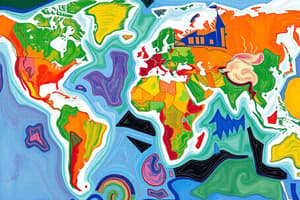Podcast
Questions and Answers
What is the focus of Physical Geography?
What is the focus of Physical Geography?
- Globalization and economic development
- Natural features of the Earth's surface (correct)
- Spatial analysis of geographic data
- Relationships between people and the environment
What is the term for the level of detail at which a phenomenon is studied?
What is the term for the level of detail at which a phenomenon is studied?
- Scale (correct)
- Spatial analysis
- Region
- Location
What type of map shows relief and elevation of the Earth's surface?
What type of map shows relief and elevation of the Earth's surface?
- Cartograms
- Thematic Maps
- Topographic Maps (correct)
- GIS Maps
What is the term for the acquisition of data about the Earth's surface through aerial or satellite imagery?
What is the term for the acquisition of data about the Earth's surface through aerial or satellite imagery?
What is the idea that the environment shapes human behavior and culture?
What is the idea that the environment shapes human behavior and culture?
What is the term for a specific point on the Earth's surface?
What is the term for a specific point on the Earth's surface?
What is the term for the pursuit of balance between human needs and environmental protection?
What is the term for the pursuit of balance between human needs and environmental protection?
What is the study of the relationships between people and the environment?
What is the study of the relationships between people and the environment?
What is the term for the increasing interconnectedness of the world's economies and cultures?
What is the term for the increasing interconnectedness of the world's economies and cultures?
What is the term for the software for analyzing and visualizing geospatial data?
What is the term for the software for analyzing and visualizing geospatial data?
Flashcards are hidden until you start studying
Study Notes
Branches of Geography
- Physical Geography: studies natural features of the Earth's surface, such as climate, landforms, and ecosystems.
- Human Geography: examines the relationships between people and the environment, including cultural, economic, and political aspects.
Key Concepts
- Spatial Analysis: examines the relationships between objects and events in space.
- Scale: the level of detail at which a phenomenon is studied, ranging from local to global.
- Place: a specific point on the Earth's surface, characterized by its unique human and physical features.
- Region: a larger area defined by shared cultural, economic, or physical characteristics.
- Location: the position of a place or feature on the Earth's surface, described by its latitude, longitude, and altitude.
Types of Maps
- Topographic Maps: show relief and elevation of the Earth's surface.
- Thematic Maps: display specific data, such as climate, population, or economic activity.
- Cartograms: represent geographic data as distorted maps, emphasizing relationships and patterns.
Geographic Tools and Techniques
- GIS (Geographic Information Systems): software for analyzing and visualizing geospatial data.
- Remote Sensing: the acquisition of data about the Earth's surface through aerial or satellite imagery.
- GPS (Global Positioning System): a network of satellites providing location and navigation data.
Human-Environment Interactions
- Environmental Determinism: the idea that the environment shapes human behavior and culture.
- Possibilism: the idea that humans have the ability to adapt to and modify their environment.
- Sustainability: the pursuit of balance between human needs and environmental protection.
Globalization and Development
- Globalization: the increasing interconnectedness of the world's economies and cultures.
- Development: the process of improving the economic and social well-being of a region or country.
- Uneven Development: the unequal distribution of resources, opportunities, and benefits across different regions and populations.
Branches of Geography
- Physical Geography focuses on the Earth's natural features, including climate, landforms, and ecosystems.
- Human Geography explores the relationships between people and the environment, covering cultural, economic, and political aspects.
Key Concepts
- Spatial Analysis examines the relationships between objects and events in space, considering proximity, distance, and patterns.
- Scale ranges from local to global, influencing the level of detail in geographic studies.
- A Place is a specific point on the Earth's surface, defined by its unique human and physical features.
- A Region is a larger area characterized by shared cultural, economic, or physical characteristics.
- Location is described by latitude, longitude, and altitude, pinpointing a place or feature on the Earth's surface.
Types of Maps
- Topographic Maps display relief and elevation of the Earth's surface, showcasing natural features.
- Thematic Maps visualize specific data, such as climate, population, or economic activity, to highlight trends and patterns.
- Cartograms represent geographic data as distorted maps, emphasizing relationships and patterns.
Geographic Tools and Techniques
- GIS (Geographic Information Systems) is software for analyzing and visualizing geospatial data, enabling spatial analysis and mapping.
- Remote Sensing involves acquiring data about the Earth's surface through aerial or satellite imagery, providing valuable insights.
- GPS (Global Positioning System) is a network of satellites providing location and navigation data, facilitating orientation and movement.
Human-Environment Interactions
- Environmental Determinism proposes that the environment shapes human behavior and culture, influencing human activity.
- Possibilism suggests that humans have the ability to adapt to and modify their environment, highlighting human agency.
- Sustainability aims to balance human needs with environmental protection, promoting long-term ecological health.
Globalization and Development
- Globalization is the increasing interconnectedness of the world's economies and cultures, driving change and integration.
- Development involves improving the economic and social well-being of a region or country, enhancing quality of life.
- Uneven Development refers to the unequal distribution of resources, opportunities, and benefits across different regions and populations, highlighting disparities and inequalities.
Studying That Suits You
Use AI to generate personalized quizzes and flashcards to suit your learning preferences.




